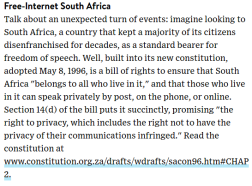IVO VEGTER is at it again, with a spate of postings published by Daily Maverick, each one more ludicrous than the next. If its not GM food, then its nuclear power that he commends. The latest effort at contrarianism is what appears to be a detailed article on 5G, labeling those who rightly question the health impacts of radio frequency electromagnetic radiation (RF EMR) guilty of nothing less than “technophobic nonsense”.
The posting begins by introducing a red herring — the unverified report that Poland’s PM Mateusz Morawiecki, had signed the ‘Global Appeal to Ban 5G in Earth and in Space’. The report was picked up by online sites, including CounterPunch, but turned out to be nothing more than a tactic to discredit those campaigning against 5G, and thus amongst similar Trojan Horse ideas punted by infocoms sites.
Which is a better weapon in the hands of right-wing charlatans, the Straw Man argument, or the good old Greek Gift?
Globalisation sites such as Global Research apparently had a field day, but as yet no independent verification of the alleged dismissal from the, wait for it, ‘The Polish Ministry of Digitalisation’.
But that my dear, is not the main point here, since Vegter should know better than to critique a public petition, for money, while ignoring the real nugget of a professional petition eligible only to those with a PhD or Medical degree!
All this while supplying sciencey-looking diagrams to demonstrate, why it is that he writes on the subject while not possessing a science degree, nor coursework in the subject at hand.
To give an indication, saying 5G spectrum ‘places squarely in the region of radar on the electromagnetic spectrum’, begs the health questions raised by this Int. J. Cancer paper, one of many, reporting an increase in the incidence of hemolymphatic cancers:
So much for the claim that these studies are all ‘self-published, non-peer-reviewed reports’. Would Vegter be so bold then, as to review the slightly more elevated petition document signed by some 50 eminent medical professionals, with the same apparent rigour, as he treated the much vaunted “Global Appeal to Ban 5G in Earth and in Space?”
I think not, since the Vegter is seemingly impervious to criticism that he is at best, a cherry-picker of facts.
Ivo thus proceeds to impute anti-5G activists on the basis that “A significant percentage of the world’s population is instinctively afraid of new technologies” in the process ignoring the ‘precautionary principle’ which has governed much scientific endeavor in the past, but sadly seems to be on the way out, so far as Huawei is concerned. Victim of what those in the tech industry might refer to as the pro-actionary principle, of doing it for the startup money, and not giving a $%^.
Then the man makes the astonishing claim that there is no substantive peer reviewed research supporting concerns about RF EMR and EMF since, “many of the academic studies cited in the petition are decades old, and nothing has come of follow-up studies to confirm or quantify the effect. Some weren’t peer-reviewed. Many are published in obscure journals. Most are conducted on animals, or even just cells in a petri dish, not humans in plausible exposure scenarios. Many have very small sample sizes. Most cases involve a correlation, rather than proof of causation. None offer a plausible mechanism of action by which electromagnetic radiation can produce the claimed effect.”
Readers may take time to review a compendium of research on the dangers of 5G and EMF, compiled by Dr. Martin Pall.
5G uses between 24 to 90 gigahertz frequency. Within the RF Radiation portion of the electromagnetic spectrum, the higher the frequency the more dangerous it is to living organisms.
Don’t get bamboozled by the debate on ionising vs non-ionising radiation unless you care to suck on some microwaved latte while reading recent papers published by the the eminent Lancet, and Environmental Research Journal:
Planetary electromagnetic pollution: it is time to assess its impact
‘Unprecedented human exposure to radiofrequency electromagnetic radiation from conception until death has been occurring in the past two decades. Evidence of its effects on the CNS, including altered neurodevelopment and increased risk of some neurodegenerative diseases,is a major concern considering the steady increase in their incidence.’
5 G wireless telecommunications expansion: Public health and environmental implication
“Radiofrequency radiation (RF) is increasingly being recognized as a new form of environmental pollution. Like other common toxic exposures, the effects of radiofrequency electromagnetic radiation (RF EMR) will be problematic if not impossible to sort out epidemiologically as there no longer remains an unexposed control group.”
Try these pages for some further anti-dote to the Daily Maverick media factory:
Scientific Research on 5G, 4G Small Cells, Wireless Radiation and Health
https://www.researchgate.net/publication/279863242_Oxidative_mechanisms_of_biological_activity_of_low-intensity_radiofrequency_radiation
https://www.researchgate.net/publication/311002388_When_theory_and_observation_collide_Can_non-ionizing_radiation_cause_cancer
https://journals.lww.com/epidem/fulltext/2009/11001/Adverse_Health_Effect_of_Radiofrequency_Exposures.617.aspx

 A photograph from the period shows me at a terminal, wearing a Mondo 2000 t-shirt, at the very first NetDemocracy event in the country hosted by Nodi Murphy and Stephen Garrett. A simple information activist, participating in an online Internet Relay Chat (IRC) chat with Minister Pallo Jordan alongside 120 citizens from around the country, all of whom happened to be online.
A photograph from the period shows me at a terminal, wearing a Mondo 2000 t-shirt, at the very first NetDemocracy event in the country hosted by Nodi Murphy and Stephen Garrett. A simple information activist, participating in an online Internet Relay Chat (IRC) chat with Minister Pallo Jordan alongside 120 citizens from around the country, all of whom happened to be online.